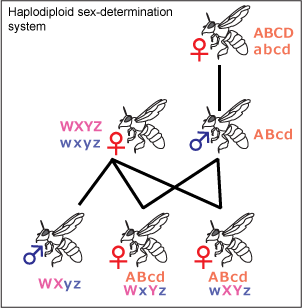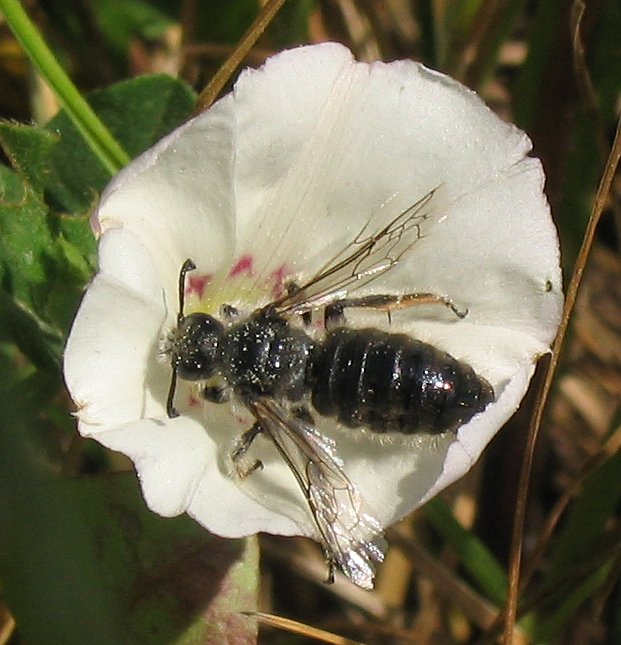|
Lasioglossum
The sweat bee genus ''Lasioglossum'' is the largest of all bee genera, containing over 1700 species in numerous subgenera worldwide.Gibbs, J., et al. (2012)Phylogeny of halictine bees supports a shared origin of eusociality for ''Halictus'' and ''Lasioglossum'' (Apoidea: Anthophila: Halictidae).''Molecular Phylogenetics and Evolution'' 65(3), 926-39. They are highly variable in size, coloration, and sculpture; among the more unusual variants, some are cleptoparasites, some are nocturnal, and some are oligolectic. Most ''Lasioglossum'' species nest in the ground, but some nest in rotten logs. Social behavior among species of ''Lasioglossum'' is extraordinarily variable; species are known to exhibit solitary nesting, primitive eusociality, and social parasitism. Colony sizes vary widely, from small colonies of a single queen four or fewer workers to large colonies of >400 workers and perennial life cycles. The genus ''Lasioglossum'' can be divided ... [...More Info...] [...Related Items...] OR: [Wikipedia] [Google] [Baidu] |
Lasioglossum Zephyrus
''Lasioglossum zephyrus'' is a sweat bee of the family Halictidae, found in the U.S. and Canada. It appears in the literature primarily under the misspelling "''zephyrum''". It is considered a primitively eusocial bee (meaning that they do not have a permanent division of labor within colonies),Batra, S. W. T. 1966. The life cycle and behavior of the primitively social bee ''Lasioglossum zephyrum'' (Halictidae). Univ. Kansas Sci. Bull. 46:359–423. although it may be facultatively solitary (i.e., displaying both solitary and eusocial behaviors).Interactions in colonies of primitively social bees: Artificial colonies of ''Lasioglossum zephyrum '. ''PNAS''. Retrieved 08-27-2011. The species nests in burrows in the soil. Taxonomy and phylogeny |
Lasioglossum Malachurum
''Lasioglossum malachurum'', the sharp-collared furrow bee, is a small European halictid bee. This species is obligately eusocial, with queens and workers, though the differences between the castes are not nearly as extreme as in honey bees. Early taxonomists mistakenly assigned the worker females to a different species from the queens. They are small (about 1 cm), shiny, mostly black bees with off-white hair bands at the bases of the abdominal segments. ''L. malachurum'' is one of the more extensively studied species in the genus ''Lasioglossum'', also known as sweat bees. Researchers have discovered that the eusocial behavior in colonies of ''L. malachurum'' varies significantly dependent upon the region of Europe in which each colony is located. Taxonomy and phylogeny ''L. malachurum'' was described by the entomologist William Kirby in 1802. This species of bees fall within the genus ''Lasioglossum'', which is the largest bee genus. ''Lasioglossum'' falls within the f ... [...More Info...] [...Related Items...] OR: [Wikipedia] [Google] [Baidu] |
Lasioglossum Birkmani, Female, Back1, Nacogodoches County, Texas 2012-10-23-08
The sweat bee genus ''Lasioglossum'' is the largest of all bee genera, containing over 1700 species in numerous subgenera worldwide.Gibbs, J., et al. (2012)Phylogeny of halictine bees supports a shared origin of eusociality for ''Halictus'' and ''Lasioglossum'' (Apoidea: Anthophila: Halictidae).''Molecular Phylogenetics and Evolution'' 65(3), 926-39. They are highly variable in size, coloration, and sculpture; among the more unusual variants, some are cleptoparasites, some are nocturnal, and some are oligolectic. Most ''Lasioglossum'' species nest in the ground, but some nest in rotten logs. Social behavior among species of ''Lasioglossum'' is extraordinarily variable; species are known to exhibit solitary nesting, primitive eusociality, and social parasitism. Colony sizes vary widely, from small colonies of a single queen four or fewer workers to large colonies of >400 workers and perennial life cycles. The genus ''Lasioglossum'' can be divide ... [...More Info...] [...Related Items...] OR: [Wikipedia] [Google] [Baidu] |
Dialictus
''Dialictus'' is a subgenus of sweat bees belonging to the genus ''Lasioglossum''. Most of the members of this subgenus have a metallic appearance, while some are non-metallic. There are over 630 species worldwide. They are commonly found in the Northern Hemisphere and are found in abundance in North America. Members of this subgenus also have very diverse forms of social structure making them model organisms for studying the social behavior of bees. Morphology Members of ''Lasioglossum (Dialictus)'' are small, about 3.4–8.1 mm in size, and distinguished from other halictids by a strongly arched basal vein and weakened distal veins on the forewings. Distinguishing between some of the species in ''Lasioglossum (Dialictus)'' proves to be difficult due to their “monotonous” morphology and subtle differences. Some species have been named based on geographic distribution and ecological niche rather than using any distinguishing morphological features. Molecular Gene ... [...More Info...] [...Related Items...] OR: [Wikipedia] [Google] [Baidu] |
Halictidae
Halictidae is the second-largest family of bees (clade Anthophila) with nearly 4,500 species. Halictid species are an extremely diverse group that can vary greatly in appearance. These bees occur all over the world and are found on every continent except Antarctica. Usually dark-colored (frequently brown or black) and often metallic, halictids are found in various sizes, colors and patterns. Several species are all or partly green and a few are red, purple, or blue. A number of them have yellow markings, especially the males, which commonly have yellow faces, a pattern widespread among the various families of bees. The family is one of many with short tongues and is best distinguished by the arcuate (strongly curved) basal vein found on the wing. Females in this family tend to be larger than the males. They are commonly referred to as "sweat bees" (especially the smaller species), as they are often attracted to perspiration. Ecology Most halictids nest in the ground, often in ha ... [...More Info...] [...Related Items...] OR: [Wikipedia] [Google] [Baidu] |
Eusociality
Eusociality (from Greek εὖ ''eu'' "good" and social), the highest level of organization of sociality, is defined by the following characteristics: cooperative brood care (including care of offspring from other individuals), overlapping generations within a colony of adults, and a division of labor into reproductive and non-reproductive groups. The division of labor creates specialized behavioral groups within an animal society which are sometimes referred to as 'castes'. Eusociality is distinguished from all other social systems because individuals of at least one caste usually lose the ability to perform at least one behavior characteristic of individuals in another caste. Eusocial colonies can be viewed as superorganisms. Eusociality exists in certain insects, crustaceans, and mammals. It is mostly observed and studied in the Hymenoptera (ants, bees, and wasps) and in Blattodea (termites). A colony has caste differences: queens and reproductive males take the roles of the ... [...More Info...] [...Related Items...] OR: [Wikipedia] [Google] [Baidu] |
Genus
Genus ( plural genera ) is a taxonomic rank used in the biological classification of extant taxon, living and fossil organisms as well as Virus classification#ICTV classification, viruses. In the hierarchy of biological classification, genus comes above species and below family (taxonomy), family. In binomial nomenclature, the genus name forms the first part of the binomial species name for each species within the genus. :E.g. ''Panthera leo'' (lion) and ''Panthera onca'' (jaguar) are two species within the genus ''Panthera''. ''Panthera'' is a genus within the family Felidae. The composition of a genus is determined by taxonomy (biology), taxonomists. The standards for genus classification are not strictly codified, so different authorities often produce different classifications for genera. There are some general practices used, however, including the idea that a newly defined genus should fulfill these three criteria to be descriptively useful: # monophyly – all descendants ... [...More Info...] [...Related Items...] OR: [Wikipedia] [Google] [Baidu] |
.jpg)




